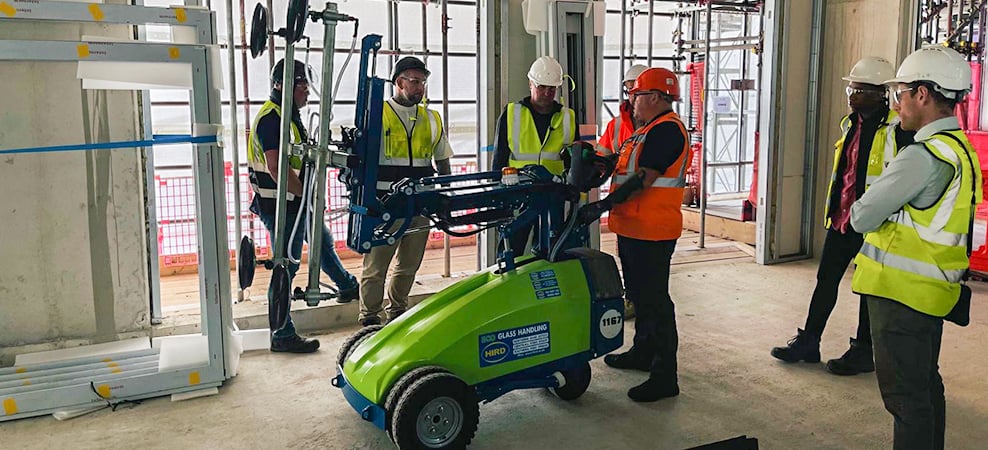Work site glazing robot training helps keep projects on track
There is a benefit of Winlet glazing robots not always mentioned.
They are so compact there is more than enough space to hold accredited training sessions on many work sites.
Hird knows all about the LEEA vacuum robot course, after all we designed and developed it – and being able to deliver the course at client premises or on their worksites is an important advantage.
That means there is no travel time to and from training centres, and time away from client glass lifting projects is kept to a minimum.
Magnify advantages
It also means our approved instructors can see first-hand the spaces operatives are going to work in and can build that perspective into the training delivered.
This is particularly helpful where façade installation clients are recruiting new operatives to work on large single-site contracts, perhaps for many weeks or months.
Hird Director John Wilding said: “Winlet glazing robots are hugely powerful tools that many of our clients are happy to admit have revolutionised the way they install glass and other non-porous sheet products.
“Glass installation productivity – with smaller teams and faster installation rates – along with improved safety, better quality and reduced operational carbon footprints, are all accepted benefits.
“These advantages are all magnified by ensuring all teams involved in glass installation projects using Winlet glazing robots have received LEEA accredited vacuum robot training.
“Proof of training is welcomed, and often required, by contractor or end-use clients. It also allows teams to work more seamlessly and flexibly, maximising productivity and safety, and accelerating the process of building high performance teams.”
Counterbalance crane training
Much the same principle applies to another course Hird designed and developed, for the counterbalance floor crane, which is also accredited by the LEEA (Lifting Equipment Engineers Association).
Staying with the LEEA vacuum robot course for a moment, though, it lasts one day, includes class and practical tuition, and can be delivered to a maximum of three delegates per session.
All aspects of operating a glazing robot are covered, starting with the regulation and guidance on using the machines and a thorough overview of their design, function and uses.
The course then goes on to cover other key topics, for example the use of glazing robot controls, operation of the machine when unloaded and loaded, operator safety codes, signalling techniques and weight assessment.
Operatives are given theoretical and practical tests and plenty of time to ask any questions necessary, with answers given by a qualified Hird training instructor who also has significant industry experience.
Qualified training instructor
Operatives who pass the course receive an LEEA certificate and photo-card valid for five years. Refresher training is then required before it can be renewed.
The LEEA counterbalance floor crane training course follows a similar, proven format. Again, it lasts a day and can be delivered at one of Hird’s training centres, at a client base or, if conditions allow, at a work site.
To deliver the course, Hird’s qualified instructor will refer to the operation of Wienold counterbalance floor cranes, such as the GML800+ and the MFC 750K mini floor crane.
Theoretical and practical tuition is followed by written tests. Operatives who pass also receive a certificate and photo-card valid for five years, renewable after refresher training.
Hird training – find out more
Whether you want your training to be carried out at one of our centres, at your company base or at a work site, Hird is here to assist with LEEA vacuum robot and counterbalance floor crane courses.
Call Hird today about these courses and the others we deliver, including: IPAF operator, CPCS A66 compact crane, RTITB vacuum lifter; CPCS A61 appointed person – and many more.
Email: [email protected]
Northern
01482 227333
Central
01302 341659
Southern
0203 174 0658
